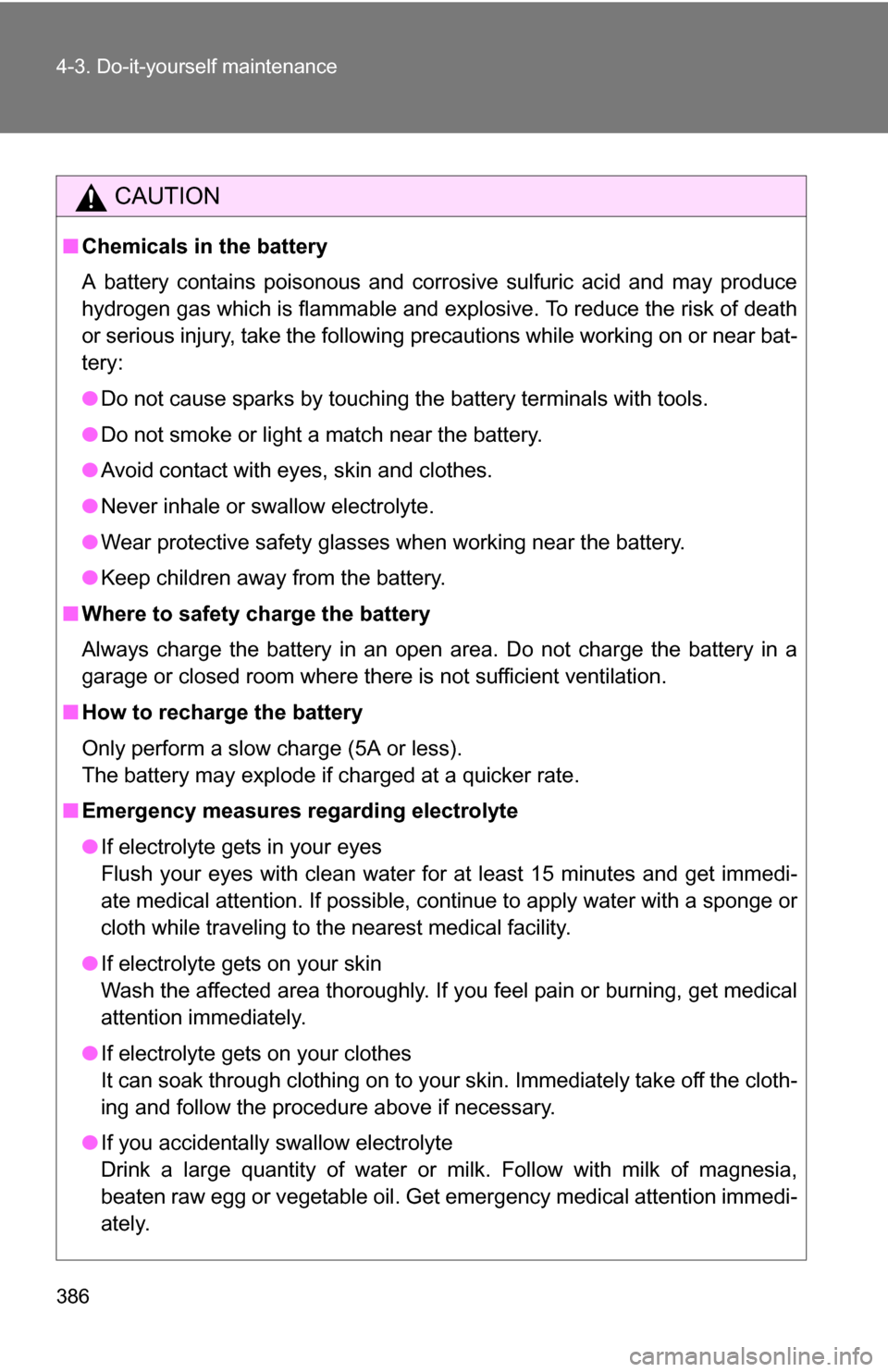Page 373 of 520
373
4-3. Do-it-yourself maintenance
4
Maintenance and care
Engine compar tment
4.0 L V6 (1GR-FE) engine
Washer fluid tank (P. 387)
Power steering fluid reservoir ( P. 383)
Engine oil level dipstick ( P. 375)
Engine coolant reservoir ( P. 380)
Engine oil filler cap ( P. 376)Brake fluid reservoir
( P. 381)
Fuse box ( P. 404)
Battery ( P. 384)
Condenser ( P. 381)
Radiator ( P. 381)
Page 374 of 520
374 4-3. Do-it-yourself maintenance
4.7 L V8 (2UZ-FE) engine
Washer fluid tank (P. 387)
Power steering fluid reservoir ( P. 383)
Engine coolant reservoir ( P. 380)
Engine oil level dipstick ( P. 375)
Engine oil filler cap ( P. 376)Brake fluid reservoir
( P. 381)
Fuse box ( P. 404)
Battery ( P. 384)
Condenser ( P. 381)
Radiator ( P. 381)
Page 384 of 520
384 4-3. Do-it-yourself maintenance
Battery■ Battery exterior
Make sure that the battery terminals are not corroded and that
there are no loose connections, cracks, or loose clamps.
Te r m i n a l s
Hold-down clamp
CAUTION
■Checking the fluid level
Take care, as the reservoir may be hot.
NOTICE
■When adding fluid
Avoid overfilling, or the power steering may be damaged.
■ After replacing the reservoir cap
Check the steering box case, vane pump and hose connections for leaks or
damage.
Page 385 of 520
385
4-3. Do-it-yourself maintenance
4
Maintenance and care
■
Checking battery condition
Check the battery condition using the indicator color.
Type A
Blue: Good condition
White: Charging is necessary.
Have the vehicle inspected by
your Toyota dealer.
Red: Not working properly,
have the battery checked by
your Toyota dealer.
Type B Green: Good condition
Dark: Charging is necessary.
Have the vehicle inspected by
your Toyota dealer.
Clear or light yellow: Not work-
ing properly, have the battery
checked by your Toyota
dealer.
■Before recharging
When recharging, the battery produces hydrogen gas which is flammable
and explosive. Therefore, before recharging:
●If recharging with the battery installed on the vehicle, be sure to discon-
nect the ground cable.
● Make sure the power switch on the charger is off when connecting and
disconnecting the charger cables to the battery.
Page 386 of 520

386 4-3. Do-it-yourself maintenance
CAUTION
■Chemicals in the battery
A battery contains poisonous and corrosive sulfuric acid and may produce
hydrogen gas which is flammable and explosive. To reduce the risk of death
or serious injury, take the following precautions while working on or near bat-
tery:
● Do not cause sparks by touching the battery terminals with tools.
● Do not smoke or light a match near the battery.
● Avoid contact with eyes, skin and clothes.
● Never inhale or swallow electrolyte.
● Wear protective safety glasses when working near the battery.
● Keep children away from the battery.
■ Where to safety charge the battery
Always charge the battery in an open area. Do not charge the battery in a
garage or closed room where there is not sufficient ventilation.
■ How to recharge the battery
Only perform a slow charge (5A or less).
The battery may explode if charged at a quicker rate.
■ Emergency measures regarding electrolyte
●If electrolyte gets in your eyes
Flush your eyes with clean water for at least 15 minutes and get immedi-
ate medical attention. If possible, continue to apply water with a sponge or
cloth while traveling to the nearest medical facility.
● If electrolyte gets on your skin
Wash the affected area thoroughly. If you feel pain or burning, get medical
attention immediately.
● If electrolyte gets on your clothes
It can soak through clothing on to your skin. Immediately take off the cloth-
ing and follow the procedure above if necessary.
● If you accidentally swallow electrolyte
Drink a large quantity of water or milk. Follow with milk of magnesia,
beaten raw egg or vegetable oil. Get emergency medical attention immedi-
ately.
Page 387 of 520
387
4-3. Do-it-yourself maintenance
4
Maintenance and care
Washer fluid
Add washer fluid in the following situations.
● Any washer does not work.
● The low washer fluid warning light comes on. (Canada only)
Open the lid.
Check the washer fluid level on
the level gauge.NORMAL
LOW
NOTICE
■When recharging the battery
Never recharge the battery while the engine is running. Also, be sure all
accessories are turned off.
Page 402 of 520
402
4-3. Do-it-yourself maintenance
Wireless remote control batter y
Replace the battery with a new one if it is discharged.
■You will need the following items:
●A coin or equivalent
● Lithium battery CR2016
■ Replacing the battery
Remove the cover using a
coin protected with tape etc.
Remove the depleted battery.
Insert a new battery with the
“+” terminal facing up.
Page 403 of 520
403
4-3. Do-it-yourself maintenance
4
Maintenance and care
■
If the wireless remote control battery is discharged
The following symptoms may occur.
●The wireless remote control will not function properly.
● The operational range is reduced.
■ Use a CR2016 lithium battery
●Batteries can be purchased at your Toyota dealer, jewelers, or camera
stores.
● Replace only with the same or equivalent type recommended by your
Toyota dealer.
● Dispose of used batteries according to the local laws.
CAUTION
■Removed battery and other parts
Keep away from children.
These parts are small and if swallowed by a child they can cause choking.
NOTICE
■For normal operation after replacing the battery
Observe the following precautions to prevent accidents.
●Always work with dry hands.
Moisture may cause the battery to rust.
● Do not touch or move any other components inside the remote control.
● Do not bend either of the battery terminals.